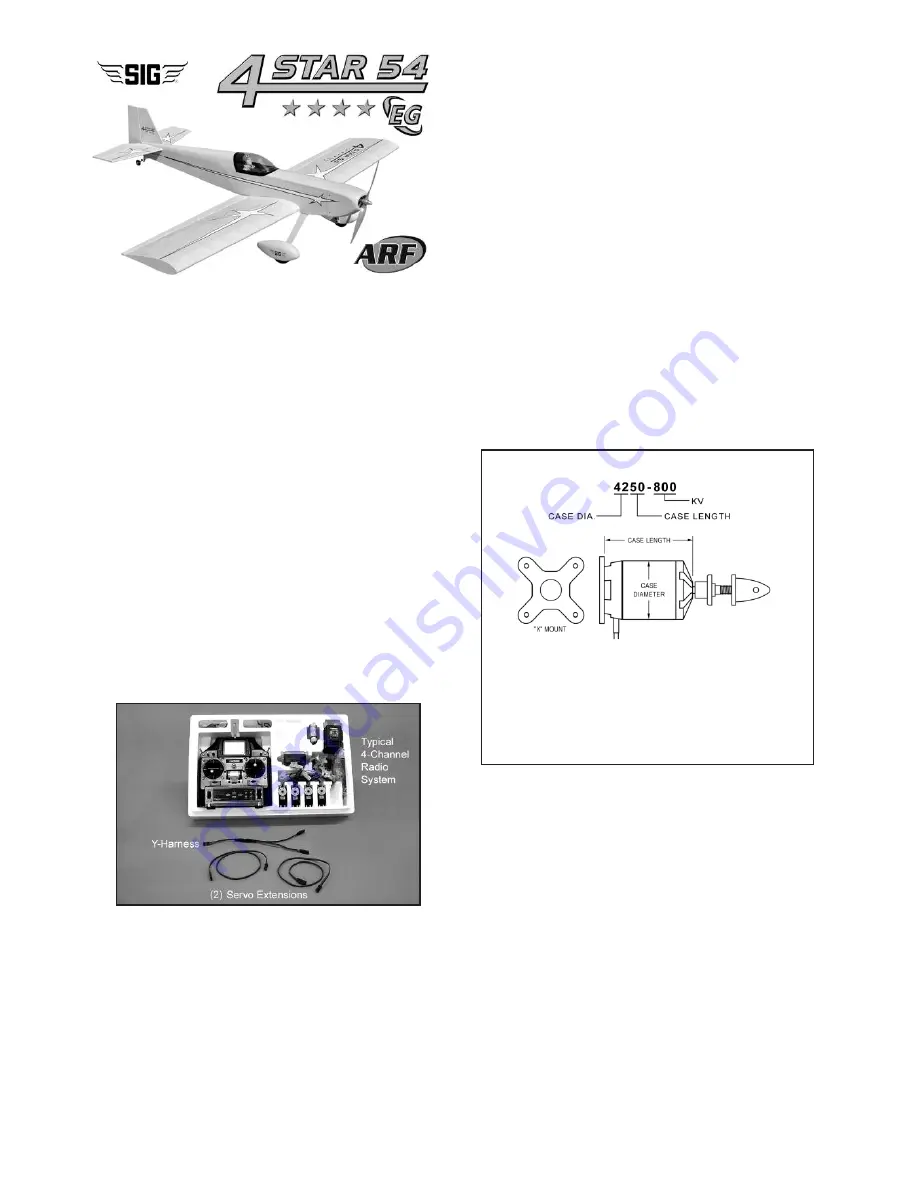
Whatever brand engine you choose, take the time to carefully
break it in according to the manufacturer's instructions. A good
running, reliable engine is a minimum requirement for the enjoy-
ment of this or any R/C model aircraft.
❑
PROPELLER FOR GLOW
Refer to the engine manufacturer’s instructions for recommenda-
tions on proper propeller size for their engine. In our experience,
most 2-stroke .40-.46 glow engines will fly the 4-STAR 54 very
nicely with a 10x6 prop.
FOR ELECTRIC POWER
❑
500 - 800 watt BRUSHLESS OUTRUNNER MOTOR
The 4-STAR 54 is designed to be powered with a 500 to 800 watt
electric brushless outrunner motor. This size motor is sometimes
referred to as a "32" or “40” class motor to those who like to make
a comparison to a glow motor. Also, the motor you choose should
be rated at 800-1000 kv, in order to turn an appropriate propeller.
Here is are some motor sizes that work well in the 4-STAR 54:
4 2 5 0 - 8 0 0
4 2 5 0 - 7 7 0
4 2 4 8 - 8 0 0
3 5 5 4 - 8 0 0
❑
MOTOR MOUNT
A laser-cut plywood adjustable motor mount is included in this kit.
It should work perfectly for any suitable brushless outrunner motor
which has an “X” or “cross” motor mount plate on the back.
❑
60-75 amp ESC (Electronic Speed Control)
We used a Castle Creations 75 amp ESC in our 4-STAR 54 pro-
totypes. This is an excellent "switching type" ESC that has a built-
in 5amp BEC that is safe to use with a 4 cell lipo battery pack.
Important Note: BEC (Battery Eliminator Circuit) allows you to
use the same battery pack to power both your motor and your
radio system, eliminating the normal radio battery pack. When
the single battery pack runs down in flight to a prescribed point,
the BEC circuit in the ESC will shut down the motor and leave
enough power to operate the radio while you land the model. Note
that the BEC feature in some ESCs does not work with 4 cell and
larger lipo battery packs - only 3 cell packs. Check the manual of
your particular ESC to learn if this is true in your case. If your
BEC is only rated for 3 cells, you have three options: 1) fly only 3
cell lipo packs (and have lower power); or 2) disable the BEC and
install a normal receiver battery pack to run the radio full time; or
3) install an aftermarket BEC that is properly rated for your setup
INTRODUCTION
Congratulations on your purchase of the SIG 4-STAR 54 EG ARF.
We hope you will enjoy this unique fun scale R/C model.
Assembly of your 4-STAR 54 EG ARF is fast and simple when
following the detailed instructions in this manual. We urge you to
read this assembly manual completely before assembly. Famil-
iarize yourself with the parts and the assembly sequences. The
successful assembly and flying of this airplane is your responsi-
bility. If you deviate from these instructions, you may wind-up with
problems later on.
Good luck with the 4-STAR. Let’s get started!
ADDITIONAL ITEMS YOU WILL NEED TO PURCHASE
In addition to this kit, you will need the following items to complete
your 4-STAR 54 and make it flyable.
❑
RADIO SYSTEM
The Four Star 54 EG requires a standard 4-channel radio system
and four to five standard size servos (number of servos depends
on whether you are using glow or electric power). In addition,
you'll need two 6"-12” long Servo Extension Chords (actual length
needed will depend on how long the wires are coming off your
servos – plan accordingly), and one Y-Harness Chord for connec-
tion of the two aileron servos to the receiver.
POWER SYSTEM - GLOW OR ELECTRIC?
The biggest decision you will have to make is whether to power
your 4-STAR 54 with a glow engine (2-stroke or 4-stroke) or an
electric motor. We have flown the 4-STAR 54 on a variety of both
types of power systems, and we make the following recommen-
dations based on our successful on-field experience.
FOR GLOW POWER
❑
ENGINE
We recommend the following size engines for the 4-STAR 54.
2-STROKE - .40 to .46 cu. in.
4-STROKE - .40 to .54 cu. in.
2
What do those numbers mean?
NOTE: This numbering system is very common, however there
are exceptions. For instance, some motor manufacturers will
list the actual diameter of the stator (armature) inside the motor
instead of the case diameter. Some may list the length of the
stator inside the motor instead of the case length. Some will
give you both if you dig far enough into their specs. Make sure
you understand the motor manufacturer’s numbering system
when shopping for a motor.


































